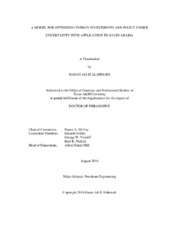| dc.description.abstract | An energy producer must determine optimal energy investment strategies in order to maximize the value of its energy portfolio. Determining optimal investment strategies is challenging. One of the main challenges is the large uncertainty in many of the parameters involved in the optimization process. Existing large-scale energy models are mostly deterministic and thus have limited capability for assessing uncertainty. Modelers usually use scenario analysis to address model input uncertainty.
In this research, I developed a probabilistic model for optimizing energy investments and policies from an energy producer’s perspective. The model uses a top-down approach to probabilistically forecast primary energy demand. Distributions rather than static values are used to model uncertainty in the input variables. The model can be applied to a country-level energy system. It maximizes the portfolio expected net present value (ENPV) while ensuring energy sustainability. The model was built in MSExcel® using the @RISK Palisade add-in, which is capable of modeling uncertain parameters and performing stochastic simulation optimization.
The model was applied to Saudi Arabia to determine its optimum energy investment strategy, determine the value of investing in alternative energy sources, and compare deterministic and probabilistic modeling approaches. The model, given its assumptions and limitations, suggests that Saudi Arabia should keep its oil production capacity at 12.5 million barrels per day, especially in the short term. It also suggests that most of the future power-generation (electricity) demand in Saudi Arabia should be met using alternative-energy sources (nuclear, solar, and wind). Otherwise, large gas production is required to meet such demand. In addition, comparing probabilistic to deterministic model results shows that deterministic models may overestimate total portfolio ENPV and underestimate future investments needed to meet projected power demand.
A primary contribution of this work is rigorously addressing uncertainty quantification in energy modeling. Building probabilistic energy models is one of the challenges facing the industry today. The model is also the first, to the best of my knowledge, that attempts to optimize Saudi Arabia’s energy portfolio using a probabilistic approach and addressing the value of investing in alternative energy sources. | en |


